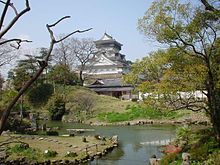



Kokura (小倉市, Kokura-shi) is an ancient castle town and the center of modern Kitakyushu, Japan. Kokura is also the name of the penultimate station on the southbound San'yō Shinkansen line, which is owned by JR West. Ferries connect Kokura with Matsuyama on Shikoku, and Busan in South Korea.
History
| This section needs additional citations for verification. Please help improve this article by adding citations to reliable sources in this section. Unsourced material may be challenged and removed. (September 2020) (Learn how and when to remove this message) |
Edo period


The Ogasawara and Hosokawa clans were daimyō at Kokura Castle during the Edo period (1603–1868). Miyamoto Musashi, samurai swordsman, author of The Book of Five Rings and founder of the Hyoho Niten Ichi-ryū, famous for its use of two swords, lived in the Kokura castle under the patronage of the Ogasawara and Hosokawa clans briefly during 1634.
Meiji period
After the end of the Tokugawa Shogunate, Kokura was the seat of government for Kokura Prefecture. When the municipal system of cities, towns and villages was introduced, Kokura Town was one of 25 towns in the prefecture, which later merged with Fukuoka Prefecture. Kokura was upgraded to city status in 1900.
World War II
Kokura was the primary target for the "Fat Man" atomic bomb on August 9, 1945, but on the morning of the raid, the city was obscured by morning fog. Kokura had also been mistaken for the neighboring city of Yahata the day before by the reconnaissance missions. Since the mission commander Major Charles Sweeney had orders to drop the bomb visually and not by radar, he diverted to the secondary target, Nagasaki. The planes, however, did fly over Kokura and were extremely close to executing the mission drop.
Post-war
When the city of Kitakyushu was created in 1963, Kokura was divided into Kokura Kita ward in the north, and Kokura Minami ward in the south.
Notable residents
- Matsumoto Seichō – writer
- Miyamoto Musashi – swordsman and rōnin
- Mori Ōgai – physician, translator, novelist and poet
- Tetsuya Theodore Fujita – Meteorologist
Notable figures born in Kokura
- Tsukasa Hojo, mangaka
- Leiji Matsumoto, mangaka
- Masumi Mitsui, 10th Battalion, CEF.
- Linda Yamamoto, singer and J-pop idol
- Satoru Nomura, yakuza godfather, leader of the Kudo-kai
Festivals
The Gion Festival of Kokura is called the "Gion of Drums" and celebrates the life of local folk-hero Muhomatsu.
Notable facts
The city is the site of the main dojo (honbu) of Miyamoto Musashi's sword school, Hyoho Niten Ichi-ryū.
See also
References
- Daley, Tad (2010). Apocalypse Never: Forging the Path to a Nuclear Weapon-free World. Piscataway, NJ: Rutgers University Press. pp. 239–241. ISBN 978-0-8135-4949-1.
- Collie, Craig (3 August 2012). "Target Nagasaki: the Men Who Dropped the Second Bomb". The Telegraph. Archived from the original on 5 August 2012. Retrieved 9 May 2024. "an extract from his new book, Nagasaki"
{{cite web}}: CS1 maint: postscript (link) - Collie, Craig (2013). Nagasaki : the Massacre of the Innocent and the Unknowing. London: Portobello Books. pp. 25–6, 59, 60, 119, 128, 138, 151–152, 156, 176, 177, 179–182. ISBN 978-1-84627-442-8 – via Internet Archive.
- "Dojos list « 兵法二天一流". Archived from the original on 2011-11-14. Retrieved 2011-11-15.
33°53′N 130°53′E / 33.883°N 130.883°E / 33.883; 130.883
Categories: